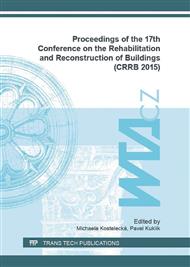[1]
B. Piwakowski, M. Kaczmarek, P. Safinowski; Evaluation of concrete cover by surface wave technique: Identification procedure. In: . b. r., pp.276-279.
DOI: 10.1063/1.3703188
Google Scholar
[2]
Z. Liu, W. Hansen; Freezing characteristics of air-entrained concrete in the presence of deicing salt. Cement and Concrete Research. 2015, 74: 10-18.
DOI: 10.1016/j.cemconres.2015.03.015
Google Scholar
[3]
J.J. Valenza, G.W. Scherer; A review of salt scaling: I. Phenomenology. Cement and Concrete Research. 2007, 37(7): 1007-1021.
DOI: 10.1016/j.cemconres.2007.03.005
Google Scholar
[4]
J.J. Valenza, G.W. Scherer; Mechanism for salt scaling of a cementitious surface. Materials and Structures. 2007, 40(3): 259-268.
DOI: 10.1617/s11527-006-9104-1
Google Scholar
[5]
Freeze-thaw and de-icing resistance of concrete. Essen: Lund Institute of Technology, (1992).
Google Scholar
[6]
H. -S. Shang, T. -H. Yi; Freeze-Thaw Durability of Air-Entrained Concrete. The Scientific World Journal. 2013, 2013: 1-6.
DOI: 10.1155/2013/650791
Google Scholar
[7]
V. Penttala; Surface and internal deterioration of concrete due to saline and non-saline freeze–thaw loads. Cement and Concrete Research. 2006, 36(5): 921-928.
DOI: 10.1016/j.cemconres.2005.10.007
Google Scholar
[8]
Z. Sun, G.W. Scherer; Effect of air voids on salt scaling and internal freezing. Cement and Concrete Research. 2010, 40(2): 260-270.
DOI: 10.1016/j.cemconres.2009.09.027
Google Scholar
[9]
G. Wardeh, E. Ghorbel; Prediction of fracture parameters and strain-softening behavior of concrete: effect of frost action. Materials and Structures. 2015, 48(1-2): 123-138.
DOI: 10.1617/s11527-013-0172-8
Google Scholar
[10]
P. -C. Aïtcin; High-performance concrete. New York: E., 1998, 591 p. Modern concrete technology series, 5. ISBN 04-191-9270-0.
Google Scholar
[11]
CEN/TS 12390-9. Testing hardened concrete – Part: 9: Freeze-thaw resistance – Scaling. CEN, (2006).
Google Scholar
[12]
ČSN 73 1326. Stanovení odolnosti povrchu cementového betonu proti působení vody a chemických rozmrazovacích látek. ÚNMZ, (1985).
Google Scholar
[13]
ČSN 73 1380. Zkoušení odolnosti betonu proti zmrazování a rozmrazování – Porušení vnitřní struktury. ČNI, (2007).
Google Scholar
[14]
ČSN 73 1322. Stanovení mrazuvzdornosti betonu. ÚNM, (1968).
Google Scholar
[15]
EN 206. Concrete – Specification, performance, production and conformity. CEN, (2013).
Google Scholar
[16]
EN 12350-1. Testing fresh concrete – Part 1: Sampling. CEN, (2009).
Google Scholar
[17]
EN 12390-1. Testing hardened concrete – Part 1: Shape, dimensions and other requirements for specimens and moulds. CEN, (2012).
DOI: 10.3403/30254400
Google Scholar
[18]
EN 12390-2. Testing hardened concrete – Part 2: Making and curing specimens for strength tests. CEN, (2009).
Google Scholar
[19]
EN 12390-3. Testing hardened concrete – Part 3: Compressive strength of test specimens. CEN, (2009).
Google Scholar


